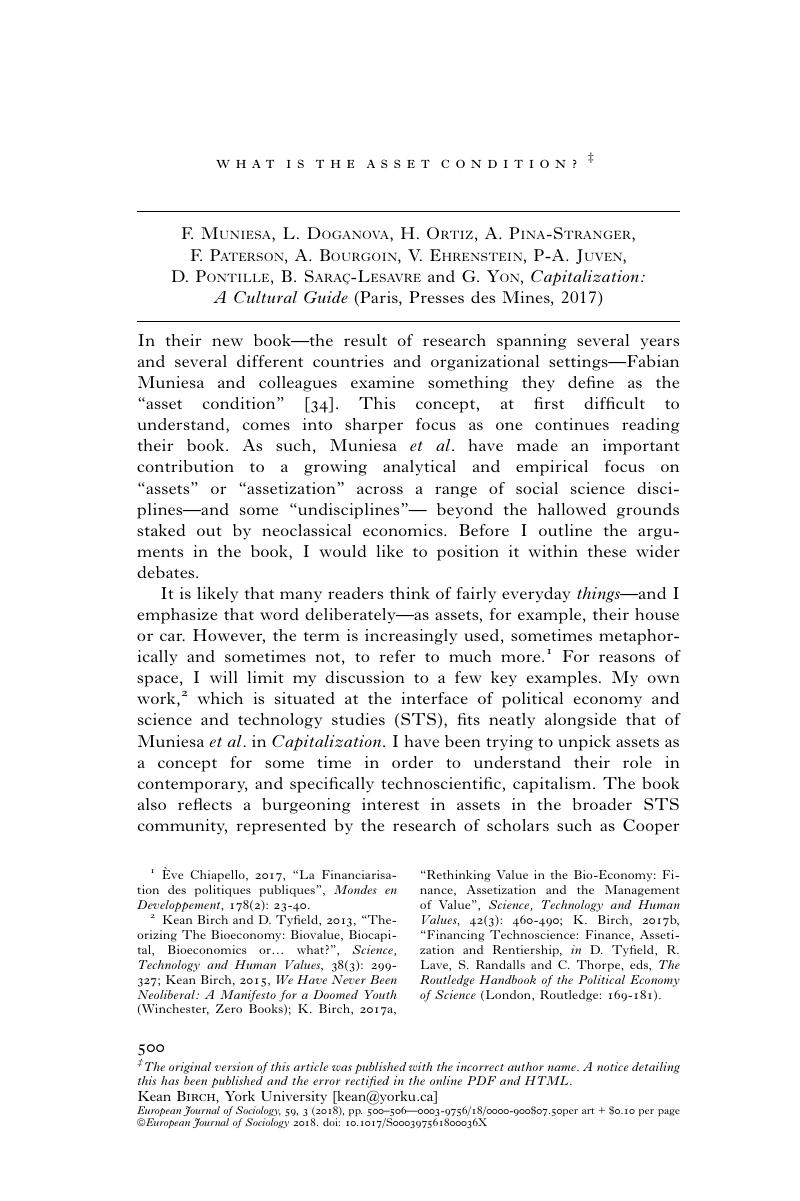Published online by Cambridge University Press: 31 January 2019

The original version of this article was published with the incorrect author name. A notice detailing this has been published and the error rectified in the online PDF and HTML.
1 Ève Chiapello, 2017, “La Financiarisation des politiques publiques”, Mondes en Developpement, 178(2): 23-40.
2 Kean Birch and D. Tyfield, 2013, “Theorizing The Bioeconomy: Biovalue, Biocapital, Bioeconomics or… what?”, Science, Technology and Human Values, 38(3): 299-327; Kean Birch, 2015, We Have Never Been Neoliberal: A Manifesto for a Doomed Youth (Winchester, Zero Books); K. Birch, 2017a, “Rethinking Value in the Bio-Economy: Finance, Assetization and the Management of Value”, Science, Technology and Human Values, 42(3): 460-490; K. Birch, 2017b, “Financing Technoscience: Finance, Assetization and Rentiership, in D. Tyfield, R. Lave, S. Randalls and C. Thorpe, eds, The Routledge Handbook of the Political Economy of Science (London, Routledge: 169-181).
3 M. Cooper and C. Waldby, 2014, Clinical Labor: Tissue Donors and Research Subjects in the Global Bioeconomy (Durham, Duke University Press).
4 J. Lezaun and C. Montgomery, 2015, “The Pharmaceutical Commons: Sharing and Exclusion in Global Health Drug Development”, Science, Technology and Human Values, 40(1): 3-29.
5 P. Martin, 2015, “Commercialising Neurofutures: Promissory Economies, Value Creation and the Making of a New Industry,” BioSocieties, 10(4): 422-443.
6 P. Vezyridis and S. Timmons, 2017, “Understanding the care.data Conundrum: New Information Flows for Economic Growth”, Big Data & Society [doi.org/10.1177/2053951716688490].
7 S. Hogarth, 2017, “Valley of the unicorns: Consumer genomics, venture capital and digital disruption,” New Genetics & Society, 36(3): 250-272.
8 P. Delvenne, 2017, “Embedded Promissory Futures: The Rise of Networked Agribusiness in Argentina’s Bioeconomy”, in V. Pavone and J. Goven, eds, Bioeconomies (London, Palgrave: 227-249).
9 D. Papadopoulos, 2018, Experimental Practice (Durham NC, Duke University Press).
10 E.g. J. Nitzan and S. Bichler, 2009, Capital as Power (London, Routledge).
11 E.g. R. Dreyfus and S. Frankel, 2015, “From Incentive to Commodity to Asset: How International Law is Reconceptualizing Intellectual Property”, Michigan Journal of International Law, 36: 101-142.
12 E.g. N. Larder, S.R. Sippel and N. Argent, 2018, “The Redefined Role of Finance in Australian Agriculture,” Australian Geographer, 49: 397-418; C. Ward and E. Swyngedouw, 2018, “Neoliberalisation from the Ground Up: Insurgent Capital Regional Struggle, and the Assetisation of Land,” Antipode, 50(4): 1077-1097.
13 E.g. A. Ducastel and W. Anseeuw, 2017, “Agriculture as an Asset Class: Reshaping the South African Farming Sector,” Agriculture & Human Values, 34(1): 199-209; S. Ouma, forthcoming, “This can(‘t) be an Asset Class: The world of Money Management, ‘Society’, and the Contested Morality of Farmland Investments,” Environment and Planning A [doi.org/10.1177/0308518X18790051].
14 E.g. Chiapello 2017, cf. supra; D. Neyland, 2018, “On the Transformation of Children At-Risk into an Investment Proposition: A Study of Social Impact Bonds as an Anti-Market Device”, The Sociological Review, 66(3): 492-510.
15 E.g. E. Rosamond, 2018, “To Sort, To Match and to Share: Addressivity in Online Dating Platforms”, Journal of Aesthetics & Culture, 10(3): 32-42.
16 E.g. P. Langley and A. Leyshon, 2017, “Platform Capitalism: The Intermediation and Capitalisation of Digital Economic Circulation,” Finance and Society, 3(1): 11-31; N. Srnicek, 2016, Platform Capitalism (Cambridge, Polity Press).
17 E.g. Vezyridis and Timmons 2017, cf. infra n. 6.
18 E.g. M. Fourcade and K. Healey, 2016, “Seeing like a market,” Socio-Economic Review, 15(1): 9-29.
19 E.g. Birch 2017a, cf. infra n. 2.
20 E.g. D. Harvey, 2005, A Brief History of Neoliberalism (Oxford, Oxford University Press); J. Peck, 2010, Constructions of Neoliberal Reason (Oxford, Oxford University Press); P. Mirowski, 2013, Never Let a Serious Crisis Go to Waste (London, Verso).
21 Jens Beckert, 2016, Imagined Futures (Cambridge MA, Harvard University Press).
22 Birch 2017a, cf. infra n. 2.
23 R. Felli, 2014, “On climate rent”, Historical Materialism, 22(3-4): 251-280.
24 Kean Birch, 2016, Innovation, Regional Development and the Life Sciences: Beyond Clusters (London, Routledge).
25 See L. Doganova and F. Muniesa, 2015, “Capitalization Devices: Business Models and the Renewal of Markets,” in M. Kornberger, L. Justesen, J. Mouritsen and A. Koed Madsen, eds, Making Things Valuable (Oxford, Oxford University Press: 109-215).
26 See also D. Glabau, 2017, “Conflicting Assumptions: The Meaning of Price in the Pharmaceutical Economy,” Science as Culture, 26(4): 455-467; F. Muniesa, 2017, “On the Political Vernaculars of Value Creation,” Science as Culture, 26(4): 445-454.
27 H. Ortiz, 2013, “The Limits of Financial Imagination: Free Investors, Efficient Markets, and Crisis,” American Anthropologist, 116(1): 38-50.
28 R. Dreyfuss and S. Frankel, 2015, “From Incentive to Commodity to Asset: How International Law is Reconceptualizing Intellectual Property,” Michigan Journal of International Law, 36(4): 557-602.
29 See Kean Birch and Fabian Muniesa, forthcoming, Turning Things into Assets (Cambridge MA, MIT Press).
30 Kean Birch, 2018, “Assets, Commodities, and their Boundaries,” Paper presented at the European Association for the Study of Science and Technology Conference (Lancaster, UK).
Please note a has been issued for this article.